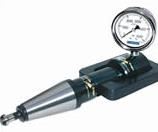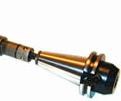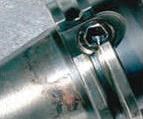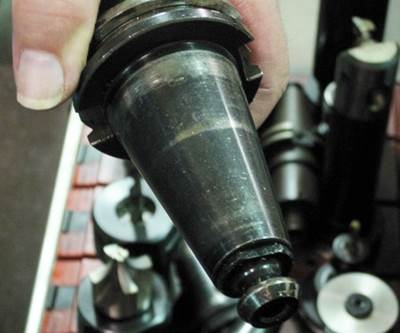Don’t Forget The Drawbar
The force that holds the toolholder in the machining center's spindle can weaken over time. If you haven't checked drawbar force in a while, this may be the weak link in your process.
Share



The term “toolholder” contains a touch of irony. A toolholder does hold the tool for the machining center, but the toolholder itself is a component that has to be held. The various tool clamping choices such as screws, collets, hydraulics and shrink fit all make it easy to focus on the toolholder’s connection to the tool. However, clamping is also performed by the spindle drawbar—a clamping mechanism that often does not draw enough attention.
Jerome Sailing has seen the effect this inattention can produce. Though repairing a drawbar costs hundreds of dollars, the damage that results from neglecting it can cost much more. Factor in spindle grinding and lost productivity from downtime, he says, and a machine crash resulting from a tool pulling out of the spindle could cost more than $10,000.
Other potential problems resulting from low drawbar force may be less extreme, but they are still costly. Chatter, repeatability problems and degradation of tool life or surface finish can all be signs that the spindle no longer holds the toolholder as tightly as it should. Having faced such difficulties as a machine shop manager, Mr. Sailing developed a simple gage for checking drawbar force that is now offered by Clamprite, his company in Auburn, Washington.
Other companies also offer gages for checking drawbar force. However the force is inspected, he says, it should be checked often enough to catch any decline in holding strength before the problems set in. He offers the following parameters for keeping toolholders tightly held.
- Frequency of inspection: Check drawbar force every 2 months, he recommends.
- How long to expect between drawbar repairs: Maybe 2 years or maybe 5. The life will depend on a number of variables, including the demands of the cutting application and the frequency of tool changes.
- Proper force: The optimal drawbar force will also vary, differing even between similar machine models. Only the manufacturer can say for certain what the force should be. In general, however, 40-taper spindles will specify 1,800 to 2,500 pounds of force, and most 50-taper spindles will specify 3,800 to 4,800 pounds of force. Some 50-taper machines will require 9,000 pounds of force or more.
HSK spindles are another matter, requiring nearly twice the force of comparable long-taper spindles, Mr. Sailing says. Because HSK spindles require high drawbar force in order for the toolholder to properly engage with the spindle face, these machines merit more frequent drawbar testing. - When to repair the drawbar: Spindles don’t come with a lot of excess holding force, he says. If they did, then the bearings would be overloaded. That’s why any significant drop from the optimal value is likely to be too much. Repair the drawbar whenever holding force has dropped below 90 percent of the manufacturer’s specification.
Fret About Fretting
Fretting is another symptom that the drawbar force may be too low. This coppery discoloration on the toolholder’s taper is caused by microscopic welding of the holder and spindle. Chatter and other vibrations, as well as bacteria in the coolant, will all contribute to fretting.
Some machinists deal with fretting in a counter-productive way. They remove it by hand using an abrasive cloth. Each time they do this, they remove a small amount of material from the taper. This degrades its accuracy, and the largest diameter often gets deformed the most. As a result, during heavy cuts, the slightly smaller toolholder is even freer to move, with the gap between holder and spindle taper allowing even more coolant and metal particles to rise into the space through capillary action. The response to fretting thus encourages more fretting.
What’s more, the damage is not just limited to the holder, Mr. Sailing notes. There is also damage inside of the spindle. To imagine the magnitude, consider that 30 to 60 toolholders undergoing fretting in a given tool magazine are all sharing this damage with a single spindle taper.
This unseen damage is an example of the kind of danger that can come from low drawbar force. Repairing the drawbar to keep the holding force high can prevent this damage by ensuring that toolholders don’t start to squirm in the first place.
Early Warning
Catching problems in this way—before they begin—is the key to regular drawbar inspection. Mr. Sailing once conducted an experiment to monitor the progression of drawbar wear. Over time (and for a fairly long time), the machining center’s drawbar force declined only gradually, following what seemed to be normal wear. Then the force began dropping rapidly from one inspection to the next, as if the drawbar mechanism had crossed a tipping point. The holding force in a drawbar comes from a stack of springs (Belleville washers), and the experiment seemed to suggest that the failure of one of these springs encourages others to fail. As a result, the effectiveness of the machining center can be lost quickly. Rather than losing the effectiveness in this way, the cheaper alternative for machining center owners is to repair the spindle before the tipping point comes.
Related Content
Mazak Achieves Production Milestone, Announces Plans to Open New Technical Center
Mazak Corporation celebrates the completion of its 40,000th machine at the Mazak iSmart Factory in Florence, Kentucky, showcasing advanced manufacturing and digital integration.
Read MoreShop Tour Video: Inside a Family-Owned Machine Shop Specializing in High-Precision Plastics
In this episode of “View From My Shop,” East Coast Precision Manufacturing guides us through their plastics job shop. Learn how this shop has quickly and inexpensively built out its shop floor, as well as how it formed a niche for itself during difficult business conditions.
Read MoreAdditive/Subtractive Hybrid CNC Machine Tools Continue to Make Gains (Includes Video)
The hybrid machine tool is an idea that continues to advance. Two important developments of recent years expand the possibilities for this platform.
Read MoreDN Solutions Acquires Heller to Boost Global Machine Tool Market Presence
DN Solutions integrates Heller Group, leveraging a 130-year legacy to enhance machining center technology and expand customer reach.
Read MoreRead Next
The Knob Problem
The retention knob is an unmistakably critical component of the machining process. However, the tightening of the knob itself can lead to the toolholder not seating securely in the machine. You may be losing tool life to knob tightness without even knowing it.
Read MoreOEM Tour Video: Lean Manufacturing for Measurement and Metrology
How can a facility that requires manual work for some long-standing parts be made more efficient? Join us as we look inside The L. S. Starrett Company’s headquarters in Athol, Massachusetts, and see how this long-established OEM is updating its processes.
Read More






























